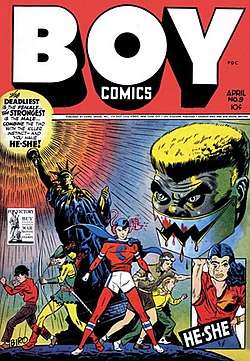Crimebuster (Boy Comics)
Crimebuster (Chuck Chandler) is a fictional boy hero, appearing as the lead feature in Boy Comics in the 1940s and 1950s. Dressed in a hockey uniform and cape, and accompanied by a performing monkey named Squeeks, he fights crime to avenge his parents' deaths.[2] He is described by Joe Brancetelli in The World Encyclopedia of Comics as "a hero, yes, but first a boy... arguably the best-handled boy's adventure feature ever to appear in comics."[3] Some sources credit the character solely to Charles Biro;[4] others co-credit Bob Wood,[1] co-credited on the first cover of the new Boy Comics title.
| Crimebuster | |
|---|---|
 Boy Comics #9, featuring Crimebuster and Iron Jaw along with other characters appearing in the publication; art by Charles Biro | |
| Publication information | |
| Publisher | Lev Gleason Image comics |
| First appearance | Boy Comics #3 (April 1942) |
| Created by | Charles Biro, Bob Wood[1] |
| In-story information | |
| Alter ego | Chuck Chandler |
| Abilities | military cadet training |
Publication history
Crimebuster was introduced in Boy Comics #3 (April 1942, the first issue of the periodical following a revamp, after two issues as Captain Battle).[5] In that issue the character's father, a heroic war correspondent, is killed by a Nazi criminal called Iron Jaw (due to his metallic prosthetic lower face). Iron Jaw has also abducted Chuck's mother, so the boy travels to France to rescue her, but during their escape she is killed by Germans. Chuck adds his military school's cape to the contemporary hockey uniform he is wearing at the time this adventure begins (which conveniently features the school's initial "C" on the chest), and takes on the name "Crimebuster".[6]
He pursues Iron Jaw until issue #15, in which the character is killed, but continues his crusade. (Iron Jaw returns later in the series.)[1][4] Chuck also tangles with a hermaphroditic serial killer named the He-She in issue #12.[7]
Although his initial adventures focused on his "crimebusting" agenda, as the superhero genre became less popular, stories focused more on the character's school life. With the war over, the school changed from Custer Military Academy to Curtis High School.[4] He stopped wearing the costume, explained in-story by a girl suggesting that it looked silly. He dropped the "Crimebuster" name altogether after issue #111 (May 1955)[8] (his friends continued to call him "C.B.")[4] when the Comics Code Authority – with its restrictions on the use of the word "crime" – was established. He continued as "Chuck Chandler" until Boy Comics ceased publication, with issue #119 (March 1956).[9]
The character was revived briefly in 1990 by AC Comics, a publisher focusing on Golden Age superheroes, in their series Femforce.[10]
In popular culture
The cover of Rage Against the Machine's album Evil Empire features a painting by Mel Ramos of a boy costumed as Crimebuster, with the letter on his chest change to a lowercase "e".[11]
References
- International hero profile
- Nevins, Jess (2013). Encyclopedia of Golden Age Superheroes. High Rock Press. p. 67. ISBN 978-1-61318-023-5.
- Brancatelli, Joe, "Biro, Charles (1911-1972)" in Maurice Horn (ed.), The World Encyclopedia of Comics (Chelsea House Publishers, 2nd ed., 1999) ISBN 0-7910-4854-3, pp. 134-135
- "Don Markstein's Toonopedia: Crimebuster". www.toonopedia.com. Retrieved 2020-04-19.
- Mitchell, Kurt; Thomas, Roy (2019). American Comic Book Chronicles: 1940-1944. TwoMorrows Publishing. pp. 169–170. ISBN 978-1605490892.
- Mougin, Lou (2020). Secondary Superheroes of Golden Age Comics. McFarland & Co. pp. 217–220. ISBN 9781476638607.
- Mitchell, Kurt; Thomas, Roy (2019). American Comic Book Chronicles: 1940-1944. TwoMorrows Publishing. p. 204. ISBN 978-1605490892.
- Benton, Mike (1992). Superhero Comics of the Golden Age: The Illustrated History. Dallas: Taylor Publishing Company. p. 154. ISBN 0-87833-808-X. Retrieved 8 April 2020.
- Schelly, William (2013). American Comic Book Chronicles: The 1950s. TwoMorrows Publishing. p. 15. ISBN 9781605490540.
- Mougin, Lou (2019-12-30). Secondary Superheroes of Golden Age Comics. McFarland. ISBN 978-1-4766-7513-8.
- "What The Kid From The Cover Of Evil Empire Looks Like Now". Kerrang!. Retrieved 2020-04-19.